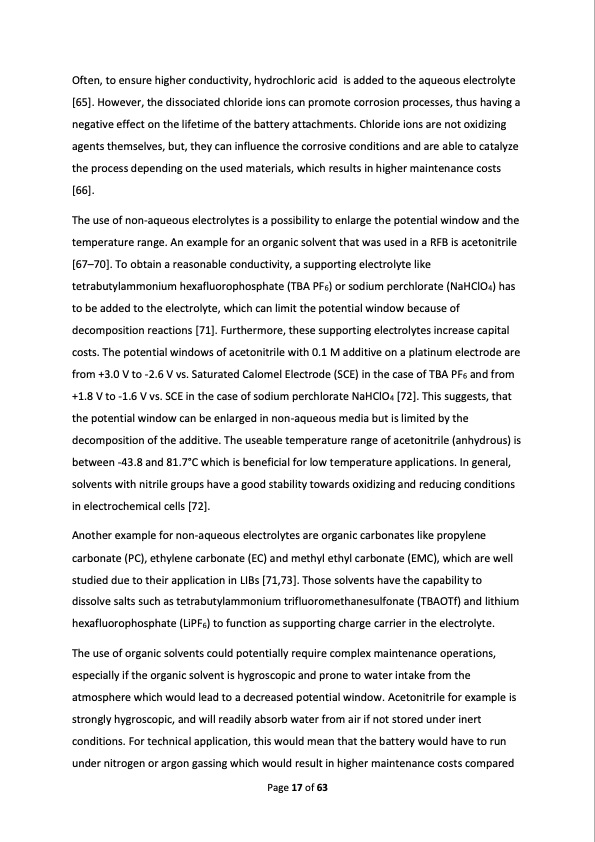
PDF Publication Title:
Text from PDF Page: 017
Often, to ensure higher conductivity, hydrochloric acid is added to the aqueous electrolyte [65]. However, the dissociated chloride ions can promote corrosion processes, thus having a negative effect on the lifetime of the battery attachments. Chloride ions are not oxidizing agents themselves, but, they can influence the corrosive conditions and are able to catalyze the process depending on the used materials, which results in higher maintenance costs [66]. The use of non-aqueous electrolytes is a possibility to enlarge the potential window and the temperature range. An example for an organic solvent that was used in a RFB is acetonitrile [67�70]. To obtain a reasonable conductivity, a supporting electrolyte like tetrabutylammonium hexafluorophosphate (TBA PF6) or sodium perchlorate (NaHClO4) has to be added to the electrolyte, which can limit the potential window because of decomposition reactions [71]. Furthermore, these supporting electrolytes increase capital costs. The potential windows of acetonitrile with 0.1 M additive on a platinum electrode are from +3.0 V to -2.6 V vs. Saturated Calomel Electrode (SCE) in the case of TBA PF6 and from +1.8 V to -1.6 V vs. SCE in the case of sodium perchlorate NaHClO4 [72]. This suggests, that the potential window can be enlarged in non-aqueous media but is limited by the decomposition of the additive. The useable temperature range of acetonitrile (anhydrous) is between -43.8 and 81.7°C which is beneficial for low temperature applications. In general, solvents with nitrile groups have a good stability towards oxidizing and reducing conditions in electrochemical cells [72]. Another example for non-aqueous electrolytes are organic carbonates like propylene carbonate (PC), ethylene carbonate (EC) and methyl ethyl carbonate (EMC), which are well studied due to their application in LIBs [71,73]. Those solvents have the capability to dissolve salts such as tetrabutylammonium trifluoromethanesulfonate (TBAOTf) and lithium hexafluorophosphate (LiPF6) to function as supporting charge carrier in the electrolyte. The use of organic solvents could potentially require complex maintenance operations, especially if the organic solvent is hygroscopic and prone to water intake from the atmosphere which would lead to a decreased potential window. Acetonitrile for example is strongly hygroscopic, and will readily absorb water from air if not stored under inert conditions. For technical application, this would mean that the battery would have to run under nitrogen or argon gassing which would result in higher maintenance costs compared Page 17 of 63PDF Image | Redox Flow Batteries Concepts Chemistries

PDF Search Title:
Redox Flow Batteries Concepts ChemistriesOriginal File Name Searched:
5870EAF5-2D70-44C8-A0A7-62D3A1462269.pdfDIY PDF Search: Google It | Yahoo | Bing
Salgenx Redox Flow Battery Technology: Salt water flow battery technology with low cost and great energy density that can be used for power storage and thermal storage. Let us de-risk your production using our license. Our aqueous flow battery is less cost than Tesla Megapack and available faster. Redox flow battery. No membrane needed like with Vanadium, or Bromine. Salgenx flow battery
| CONTACT TEL: 608-238-6001 Email: greg@salgenx.com | RSS | AMP |